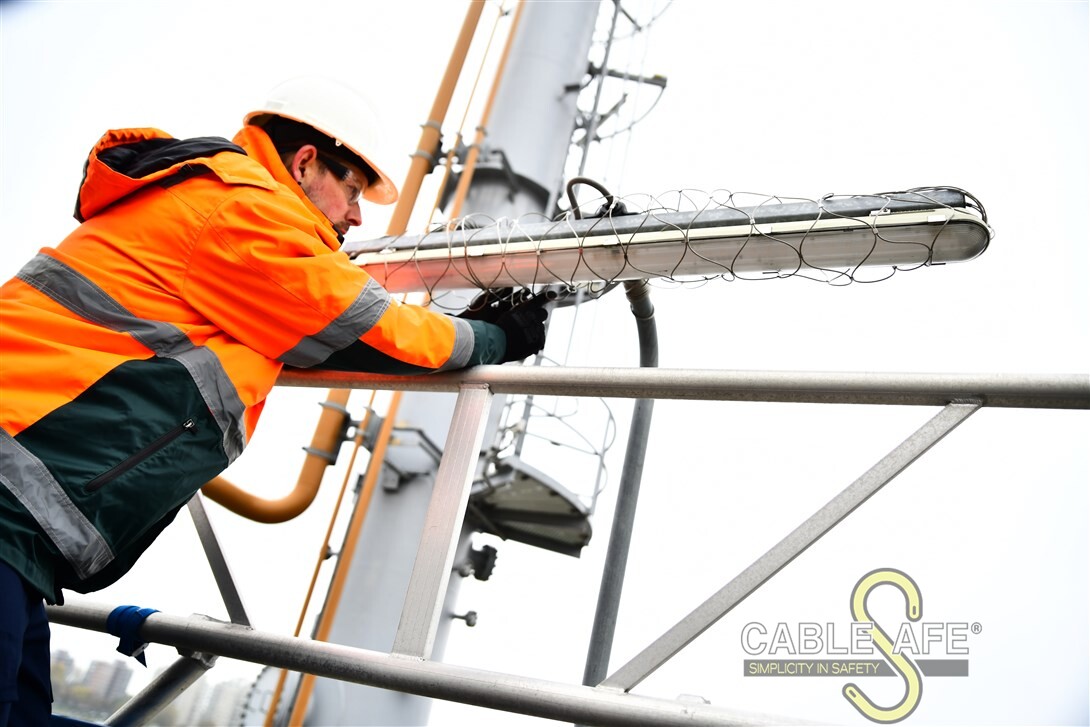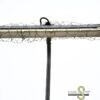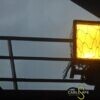Add products to quote and receive a quotation quickly.
Safety Nets
- Description
- Safe Work Load (SWL)
- Where to use
- Features
- Best practices & recommendations
- Dropped Objects Prevention
- Custom Sized Nets Available
- FAQ
- Used by
Description
The safety nets serve as a reliable securing method for equipment at height, to prevent a high risk of becoming a dropped object. The safety nets are made out of stainless steel SUS/ AISI316: which is the industry preferred high quality steel for use and operation in maritime, offshore or other harsh environments due to its good resistance against pitting corrosion.
To prevent objects from falling from height the safety nets are wrapped around the objects. The size of the object determines the size of the safety net required, standard safety net sizes make an easy match to any equipment (such as: junction boxes, lights for navigation, TL-lights or strip lights, speakers, sound boxes, cctv cameras, monitors and detector equipment).
The stainless steel high quality safety net will catch the object when it accidently drops to the workfloor or platform. These safety nets can be used for temporary installation works, but are most suitable for permanend installed objects at height that introduce dropped object risks.
A strong lanyard is supplied to weave through the netting and wrap and lock the ends of the safety net to the solid structure. This secondary retention method is commonly applied to protect the lives of the workers and pedestrians.
Safe Work Load (SWL)
Several load test are performed at the Langman Ropes factory (family owned since 1638 and still provides real craftsmanship). The safety net crimping’s are the weakest link in the safety nets. Testing these crimping’s will provide the exact safe work load (SWL) of the safety net. The safety net crimping actual load testing is witnessed by classification companies: DNVGL (Det Norske Veritas Germanischer Lloyds) and ABS (American Bureau of Shipping). Safety Lanyards load test are SGS verified. Actual Break Load of crimping is verified at:
- Safety Net (ø 2.0 mm – AISI316) – Actual Break Load: 187 kg (414 lbs),
- Safety Net (ø 2.5 mm – AISI316) – Actual Break Load: 273 kg (602 lbs)
- Lanyard (ø 4 mm – AISI316) – Actual Break Load: 1077 kg (2374 lbs)
Safe Work Load (SWL) tested and verified:
- Safety Net (2.0 mm – AISI316) – Safe Work Load: 37,5 kg (82 lbs)
- Safety Net (2.5 mm – AISI316) – Safe Work Load: 54,6 kg (120 lbs)
- Lanyard (ø 4 mm – AISI316) – Safe Work Load: 1077 kg (2374 lbs)
DNVGL & ABS of actual load testing certificates for the safety nets (Verification of Safe Work Load [SWL] by Load Testing) are available and can be submitted on request. SGS verified load test witnessed report of the safety lanyards is also available upon request.
Where to use
Our Dropped Objects Prevention Safety Nets are used when:
- Objects / Fixtures located in areas difficult to access for maintenance or inspection
- Objects / Fixtures installed which present dropped object risk at height
- Objects / Fixtures on impact zones of mobile equipment (e.g. crane booms, derricks, drill rigs, draglines and shovels)
- Objects / Fixtures and mountings exposed to vibration wear and fatigue
- Objects / Fixtures exposed to corrosion
Examples of Object / fixtures for secondary retaintion:
- Floodlights
- Speakers
- Horns
- Seld-retracting lifelines
- Visual Sign lightning
- Portable lightning
- Fixture Poles lightning
- Hangers lightning
- Photocontrol lighting
Features
Anti-Drop Safety Netting
- High quality safety net designed for extreme environments
- Standard sizes are used in a flexible design for any type of equipment
- No custom design or upfront measuring required
- High Safe Working Load (SWL) tested and verified with DNVGL and ABS
- SUS/AISI 316 high quality stainless steel wire and components
- Certificates available for use on allmost all equipment at height
- All our CableSafe Safety Netting have a 3-year warranty if installed correctly
Best practices & recommendations
Portable equipment
All portable equipment used where there is a risk of the equipment falling to an underlying level must be secured against being dropped
- Carrying pouches must always be used for radios and any other portable equipment without certified securing points
- Locks on pouches must have a double securing mechanism to prevent unintentional opening
- Belt clips that allow equipment to become detached when turned 180º should not be used
- Belts with snap fasteners are not suitable for securing equipment at height
- Battery compartments and covers on portable equipment must be secured to prevent internal components from falling.
Remember even small items falling from significant heights can cause injury and distractions. Ensure all personal equipment (tally books, pens, calipers, cameras, water bottles etc.) is secure in a fastened pocket or carry pouch. If the item is not required for the task, do not carry it at height – leave it at ground level.
Securing Tools >5kg / 11lbs
- All use of heavy tools and hand-held machinery where equipment may fall to an underlying level must be risk assessed
- All heavy tools and hand-held machinery used at height must be secured against being dropped, both when in use and while being transported
- Securing points for tools and machinery must be in place above the work site, attached to the surrounding structure, not to scaffolding
- Tools heavier than 2kg should not be secured to the body, secure them to the adjacent worksite structure
- One piece sledge hammers (forged construction with secured head) should be used at height
- The attachment points / devices on tools shall be documented and all securing wires inspected in accordance with the manufacturers recommendations
- The securing wire must be as short as possible to reduce shock loading effect
- Energy absorbing lanyards and tethers can stretch beyond the safe calculations or drop distance, therefore fixed securing wires should be used on heavy tools at height, according to the work environment
- Only certified lifting equipment shall be used as securing devices (where appropriate)
- Tools used at height should be checked out / in (see Page 54) to ensure that nothing is left behind.
Securing of Personnel
- The choice of equipment to be used must be made after evaluating the work place environment
- Established control procedures must be followed before, during and after use
- Anyone using personal protective equipment against falls from height must have documented training (including rescue method training)
- Nobody shall work alone or unattended when using fall arrest equipment
- Everyone involved in the work scope must have sufficient training and awareness of the equipment and safety procedures
- A ‘Buddy’ check of all fall arrest, rigging and other equipment must be carried out
- The necessary rescue equipment and trained personnel must always be available at the workplace
- Fall arrest equipment must have CE approval, incorporate an anti-trauma safety device and comply with an accepted standard
- The equipment shall be checked EVERY TIME before use and must be checked at least every 6 months by a competent person
- The date for next inspection must be clearly shown on the equipment
- The anchor point for suspension must be rated to 5000 lbs (22kN) – OSHA.
Dropped Objects Prevention
The accidental dropping of tools and equipment poses a very real risk to safety of workers operating at elevated heights.
It is therefore important offshore development sites have systems in place to reduce the occurrence of such incidents. Studies have shown that the impact of an object weighing less than three pounds can be fatal when dropped from a height of 30 feet or more.
Objects known to frequently cause accidents are hand tools or equipment left behind after a task, as well as equipment mounted in an elevated location that has the potential to fall due to movement or environmental conditions.
CableSafe offer a broad array of dropped item prevention tools to protect employees from potentially harmful injuries and accidents in a wide range of working environments within industrial facilities. The Dropped Objects Prevention Safety Nets are a perfect example of this.Dropped objects are prevented using secondary retention nets. These specifically designed safety nets secure, enclose and tether overhead fixtures items with the purpose to prevent an item at height from falling when its primary attachment fails. In other words this dropped object prevention safety net will catch the equipment at height when brackets corrode or connections to structure fails (e.g. impact by crane, fatigue, etc). The nets are designed for onshore and offshore installations.
Custom Sized Nets Available
We now have Safety Nets that can be fit according to the size of the object. They help to secure, enclose and tether overhead fixtures to prevent dropped objects on the workfloor. Their purpose is for secondary retention, when their primary attachment fails. The safety mesh netting is designed for onshore as well as offshore conditions and has a safety net warranty of 3 years. What makes this product unique is the fact that it can be quickly implemented as it can be made perfectly for the size of the object. No modification is required whatsoever.
Features
These custom stainless steel nets are designed and tested to cover over five times the product Safe Working Load (SWL). These light nets, yet sturdy, are designed to withstand extreme high temperatures up to 500°C (932°F) as well as extreme low temperatures down to -40°C (-40°F). Aside from these qualities, the safty nets are able to retain most fixture mounting brackets.
Materials included per Safety Net
Besides the custom sized safety net, a lanyard AKA steel securing cable is included to tether to the structure. A D-shackle to close and secure the overhead netting around the fixture and to secure the construction lanyard to the structure is also included along with a stainless steel tag.
FAQ
We get a lot of questions about our safety netting fall protection. Below you can read more about their answers.
what are safety nets?
Safety nets for fall protection are generally used at high-rise building construction sites in order to prevent objects from falling on the worksite. These nets are different from oil nets or other safety net systems in that they are a form of secondary protection in case the primary safety fails. We have two options available. One option is a safety net roll, which can be cut and used according to what size is needed. Another option we offer is custom sized nets, which is implemented fast as it requires no modification and is made for the object itself.
What is secondary retention?
Safety Nets Fit-to-size are used for secondary retention. It secures, encloses and tethers overhead fixtures to prevent dropped objects to the work floor when its primary attachment (or installation bracket) fails.
Why dropped objects prevention?
The accidental dropping of tools and equipment poses a safety threat to workers operating at elevated heights. It is therefore important to take precautionary measures to reduce the frequency of such accidents. Tools, equipment and mounted objects in an elevated location have the potential to fall due to movement. These nets are designed to protect employees from severe injuries in a wide range of working environments. The dropped object prevention safety net will catch the equipment at height when brackets corrode or connections to structure fails (e.g. impact by crane, fatigue, etc). The nets are designed for onshore and offshore installations.
Used by

Secondary retention nets preventing dropped object accidents


Anti-Drop Safety Netting. Dropped objects are a major source of incidents in heavy industries. In the drilling industry offshore dropped objects are listed in the top ten of most frequent incidents. By securing overhead fixtures items at height (e.g. speakers, cctv camera, navigation lights, flood lights or strip / TL lights, etc.) using secondary locking devices and additional securing techniques incidents are prevented and risk for dropping or falling objects is reduced significantly for people working below these items.
All our CableSafe Safety Netting have a 3-year warranty if installed correctly.
-
- OSHA Compliant Products
- Fall Protection Specialists
- Practical Solutions
References
Cablesafe® are developed for the heavy industries with safety as its highest priority. Cablesafe Safety innovations have proven its usefulness for industries such as; refineries, chemical plants, shipbuilding, electrical and nuclear installation. Employees and contractors are convinced users of Cablesafe Safety Products. Some multinationals prescribe the use of Cablesafe in own company procedures to adhere to the highest safety practices.




























